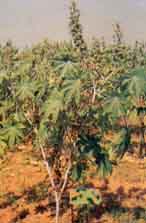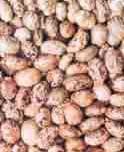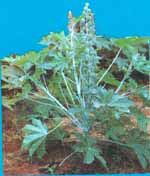|
Morphology

|
- tall glabrous annual some times shrubby or sub arboreous, leaves
alternate, broad palmately Seven to many lobed, serrate,
flowers large, in terminal sub panicle racemes, monoecious,
apetalous, upper male crowded lower female .
|
Plant habitat
- The plant if grown on a field scale is an annual requiring
about 280 days from seeding to drying.
- But if it is grown in gardens or in backyards of houses where
there is a constant supply of water, the plant lives for a
number of years.
- Both the annual and perennial are branchy types.
- This branchy character is very much influenced by environmental
factors such as type of soil, fertility of soil, moisture,
spacing etc.
- Each branch bears one or more spikes and hence, as a field
crop branching is preferred.
- Annual plants may have from 3-30 side spikes depending on
environmental conditions.
- In the case of perennials the plant may attain height of 9.15
m even and naturally will have very large number of branches
and spikes.
- Types having primary branches, secondary branches and tertiary
branches have been obtained.
- The main spike is the first to emerge: 20 to 30 days later
primary branches emerge and at the same interval secondary
and tertiary branches emerge.
- This prolongs the harvesting period from December to March.
- It will therefore, be most advantageous if strains bearing
single spikes but yielding as much as those with three orders
of branching could be isolated.
- This will simplify the harvesting and the crop will be off
the field within 6 months, where as now it takes 9-10 months.
Height of plants
- Like branching the plant height is also greatly influenced
by environment.
- It is usually found that in poorer types of soils and scarcity
of moisture, the plants attain heights of 30-90 cm but the
same varieties if planted in fertile soils with good rainfall
conditions may attain heights of 3.0 to 4.0 metres.
- As a field crop it is not advantageous to have plants taller
than 1.5 to 2 metres
- If they are taller, harvesting becomes very difficult and
damage due to heavY winds is also severe.
Colour of stem
- The colour of the stem is variable.
- All cultivated varieties in India belong to either red or
green types.
- Pink and sulphur white stems are to be found mainly in ornamental
varieties grown in gardens, although these plants thrive well
in the fields also.
- The stem colours are divided into five categories viz.
1. bright green
2. Green with reddish-bluish on the sunny side
3. Caranine or rose red
4. Mahagany red and
5. Purple (dark red)
Leaves
- The size of the leaf varies in different varieties.
- Certain varieties are characterized by large leaves where
as others bear only small leaves.
- The leaves are simple and palmate.
- The number of lobes vary from 7-11.
- There are very few leaves either with 7-11 lobes and great
majority have 9-10 lobes.
- The length of the leaf (measured from base of leaf to tip
of mid lobe) varies a great deal.
- The maximum length is 33 cm. The leaf is usually green, but
this is associated with the colour of the stem.
- Incase of green stem, the leaf and mid ribs are all green.
Incase of red stem the young leaves have red tinge which becomes
green when the leaf is fully developed; but the mid rib maintains
the reddish tinge.
The Root System
- The root system consists of main tap root, secondary roots
and tertiary roots.
- The tap root looks like an extension of the stem below the
soil.
- The secondary roots are branches of the tap root and these
are restricted to the upper 30-inch region.
- The secondary roots mostly travel parallel to the ground,
with a slight bend downwards.
- These grow to about three or four feet.
- The tertiary roots are not very long, hardly 12 to 18 inches.
- Root hairs have not been noticed in castor.
Nature of Fruits

|
Spiny , Non-spiny
- In case of spiny fruits there is variation in
the length of spines.
- In some cases the spines are short and in some long.
- There are about 150 spines per fruit.
- In case of non-spiny fruits, the skin of the fruit
is generally smooth.
- The non-spiny fruits can be further sub-divided into
two groups, (I) smooth and (ii) warty where the epicarp
is rugged.
|
Size of Fruits
- There is great variation in the size of fruits.
- In general, the size of seed is in direct proportion to the
size of fruits.
- The size of fruits could be divided into four major groups,
namely a) Very small, b) Small, c) Medium and, d) Large.
- The large fruits usually contain large seeds which have a
low oil content, i.e., less than 40 per cent on the wholeseed.
- The medium and small seeds are the two groups to which most
of the cultivated varieties of Indian castor belong.
- Their oil content varies from 45 per cent to 57 per cent.
- Very small fruits are usually found in ornamental plants in
some perennial types and some times as a variation in cultivated
varieties.
Colour of Fruits
- Practically, all cultivated varieties have green fruits.
- But plants with grades of mahogany, pink and sulphur-white
fruits have also been observed and isolated.
Seed features

|
Locules in Fruits
- There are usually three locules in castor fruit.
But fruits with two and four locules have also been
noticed.
|
Fruit Dehiscence
- The local varieties raised by the farmers are all dehiscent
and hence harvesting of fruits has to be done before the fruits
are completely dry.
- The harvested fruits are then dried in the sun and threshed.
- Dehiscent fruits are very easy for threshing, but harvesting
them before full maturity affects the oil content.
Seed Size
- There is a great range of variation in seed size.
- The smallest seed noticed is 7.95 mm. X 5.30 mm., while the
largest is 20.95 mm. X 13.50 mm.
- Between these two extremes all intermediate stages could be
found.
- The common cultivated types have seed-size ranging from 11.19
mm. X 7.79 mm. to 13.54 mm X 9.80 mm.
Caruncle
- In the Indian varieties, caruncle is always present. So
far no varieties have been noticed, without caruncle.
Seed Colour
- A number of colours are to be found in castor seed.
- The most striking ones are:- Red, white, grey, faint chocolate,
deep chocolate and purple.
Mottling on Seed
- A great variation is to be found in the expression of
this character.
- The range is from no mottling to such thick mottling, that
at times it is difficult to distinguish between the ground
colour and the colour of mottling.
Space filled by endosperm within the seed coat
- In most cases, the endosperm completely fills the space
within the seed coat.
- This makes the seed heavy and difficult to be crushed easily
by pressing with fingers.
- But there are medium-seeded varieties where the endosperm
does not fully fill the space within the seed coat.
- Some empty space is left.
- Such seed is easy to crush by pressing with the thumb.
- This should not be confused with shrunken endosperm resulting
from want of moisture in the field at the time of seed formation.
- This character of the endosperm not filling the seed cavity
completely,
- causes some damage to seed at the time of threshing.
- With seed that is well filled, there would be hardly any broken
seed after threshing, but with seed that is not well filled
with endosperm, there would be usually five per cent broken
seed at the end of threshing.
 Top
Top
Growth

|
- Castor seed
takes around 7-8 days in Kharif and 15 days in winter
to germinate depending on the prevailing temperatures.
- The plants may attain a height of 30-90cm but the
same varieties if they planted in fertile soils with
good rainfall conditions may attain heights of 3 to
4 metres.
- As a field crop it is not advantageous to have plants
taller than 1.5 to 2.0 meters.
- If they are taller harvesting becomes very difficult
and damage due to heavy winds is also severe.
|
- As castor plant is branching type it produce spikes in
the main shoot as well as on the branches of primary, secondary
and tertiary order.
- The main stem terminates in a spike and this is known as the
main spike.
- This is followed by side spikes which get ready for harvest
at different intervals.
- Usually the main spike ready for harvest by 180 days after
sowing.
- The local castor varieties have shattering nature and thus
periodical pickings are necessary.
- The inflorescence first appears in the form of a bud.
- For the bud to develop into a receme it takes 8-15 days.
- When all the flowers on spike have fully emerged, it is easy
to make out whether the spike is mostly female, partially
female or otherwise.
- In castor both the pistillate and staminate flowers are borne
on the same pedunale and thus forms a monoecious receme.
- Usually the pistillate flowers are at the top and the staminate
flowers at the base.
- Removal / Nipping of axillary buds on the main stem soon after
the initial emergence of the primary receme reduce the duration
of crop and thus facilitates to grow another crop after castor.
- Nipping of axillary buds results in full and synchronous development
of recemes/spikes.
- The castor plant has a slender tap root whose size and depth
depend on the type of soil, soil moisture and temperature
and variety.
- The number and extent of lateral roots arising from the tap
root vary and these are restricted to the upper 30 inch region.
- Secondary roots mostly spread horizantally and grow about
3 to 4 feet.
- Tertiary roots are not vary long, hardly 12" to 18".
- Root hairs are absent in castor.
 Top
Top
Inflorescence
- Usually the main axis and the branches terminate in inflorescence.
- The inflorescence first appears in the form of a bud.
- The time required for the appearance of such bud from seeding
varies with different varieties.
- For the bud, to develop into a raceme it taken 8 to 15 days.
- When all the flowers on a spike have fully emerged, it is
easy to make out whether the spike is mostly female, partially
female or otherwise.
Male flowers
|

Male spike
|
- Calyx membranous,
splitting into 3-5 valvate segments, stamens vary
many filaments crowded, variously connate or in branching
clusters, anther cells distinct, distant, sub globose,
divergent, pistillode .
|
Female flowers

Female spike |
- Calyx spathaceous,
caducous, ovary 3 celled, styles short or long, spreading.
- Often very large, entire 2-fid or 3-partite, feathery
or papillose; cells 1 ovuled.
- Capsules of 3,2-valved cocci, Seeds oblong, testa
crustaceous, albumen fleshy, cotyledons broad flat.
|
Nature of spike
- In castor both the pistillate and staminate flowers are
borne on the same peduncle and thus it forms a monoecious
raceme.
- Usually the pistillate flowers are at the top and the staminate
ones at the base.
- In normal inflorescence the pistillate flowers occupy about
30-50% of the portion of the spike and the remaining lower
portion by staminate flowers.
- The proposition of the part of raceme occupied by each type
of flower gives a different appearance to the spike and these
form different types.
- These types could be classified into three major groups.
Mostly female spike
- Pistillate flowers appears from the base of the spike
covering the entire length with fruits.
- The staminate flowers are clustered at the base of the peduncle
and some times dispersed in female flowers at the lower end
only.
Partially female spike
- Roughly the upper half of the spike length is full of
pistillate flowers (and hence full of fruits) whereas the
lower half bears staminate flowers and hence gives a vacant
appearance.
Mostly male spike
- Fruits clustered only at the upper one third of the spike.
- The remaining lower two-third is occupied by male flowers,
which wither and thus give an empty look.
- The local varieties of Castor in Telangana region of A.P and
also many other states are of this type.
shape of spike
- The shape of spike varies greatly.
- The different shapes are confined to the mostly female group
described above.
- Mostly in male group there is no variation in the shape whereas
incase of partially female group, certain shapes are discernible
but are not so conspicuous.
- The following are the more important shapes found in mostly
female types:
Long cylindrical
- Though the tip of the spike usually becomes narrow.
- Yet the whole appearance is like a narrow cylinder with uniform
diameter.
Long conical
- At the base, the spike is broad and becomes very narrow
at the tip thus giving an appearance of a cone.
Sequence of opening of flowers
- It is commonly believed that the staminate flowers open
first.
- The interval between opening of the two types of flowers varies
a great deal.
- Pistillate flowers commence opening at 11 p.m but the maximum
numbers open between 4.30 A.M to 5.00 A.M at a temperature
of 71° F.
- The staminate flowers commence opening at 5 A.M when the temperature
was 71° F.
- By following the aestivation of the bud, the female flower
was artificially opened and pollination was affected with
the help of camel hair brush.
- The stigma was found to be mature and receptive even 12 hrs
before opening time.
- Similar experiments showed that the stigma continues to be
receptive for 72 hours after the opening of flower.
- Pollen was collected from freshly opened staminate flowers
and was used for pollinating fresh stigmas at six hours intervals.
- It was found that the pollen so collected remains viable and
is capable of fertilisation for 60 to 66 hrs.
- From the time of opening of staminate flowers.
- Female flowers are found to exert the stigmatic lobes practically
throughout the day and that it takes nearly one to three days
for them to attain full development and become receptive.
- Pollen was shed from 4 A.M to 8 P.M. However, heavy shedding
took place between 7.30 A.M to 11.30 A.M . Pollen shedding
began at a temperature of 75°F and relative humidity of
70%.
- It reached its peak between 80°F to 86°F and at humidity
of 60%.
- A temperature of 60°F appeared to delay shedding.
- The staminate flowers were found to shed pollen for an average
of 15.67 + 0.34 days in August and 16.32 + 0.39 days in June.
- A Correlation co-efficient of 0.18 was found between the number
of staminate flowers and the length of time required for the
raceme to complete pollen shedding, indicating that lines
with different numbers of flowers per spike could be developed
to shed pollen over a long or short period such lines might
prove of value in the production of hybrid castor.
 Top
Top
Compactness Of Spike

|
- This character is clearly discernible in mostly
female spikes. Incase of partially female and
mostly male types, the spikes are usually loose
to very loose.
- The length of the spike on which fruits are borne
and the number of fruits gives a measure of compactness.
- This can be expressed in terms of fruits per linear
length.
|
The following are the main types noticed
Firmly compact
- Fruits are set very close and no space is left between
fruits.
- The fruits cannot move.
- This type harbours insect pests and is not suitable for field
crops.
Compact
- Fruits are set close to each other but slight space is
left in between fruits.
Loose
- Fruits are set well apart from one another.
Very loose
- Fruits are very much farther apart.
Blooms on the plant
- Bloom or the waxy coating found on the stem and certain
other parts of the castor plant is a natural protection to
the plant both from extremes of weather and from some insect
pests.
- Castor raised in the rabi season (October to May) showed that
plants without bloom suffered more from cold than plants with
bloom and also showed that the former suffered a more severe
attack of Jassids then the latter.
- The colour of the bloom is ashy white.
- The types of bloom found on Castor have been described under
the following categories.
No bloom
- With no bloom or waxy material whatsoever on any part
of the plant.
Single bloom
- With bloom only on stems, but not on leaves or fruits
Double bloom
- With bloom on the stem, fruits, and on the lower (dorsal)
side of leaf, but not on the upper surface (Ventral) of the
leaf.
Triple bloom
- With bloom on every part such as the stem, petiole, upper
and lower surfaces of leaves and on fruits.
- Most of the cultivated varieties of castor in India come under
the double and triple bloom groups.
 Top
Top
|
